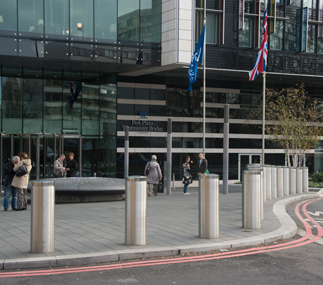Hotels and hospitality venues tend to see high levels of footfall on a continuous basis, with guests and employees passing through the doors every day. But given recent events and the heightened threat of a potential terrorist incident, hotels have been identified as one of the critical national infrastructures that is at risk. This means the hospitality sector must give considerable attention to securing assets, perimeter protection and access control measures to keep guests and employees safe from a targeted attack, writes Gavin Hepburn, sales and marketing director at ATG Access, the manufacturer of road blockers, bollards and vehicle barriers.
But of course, places of leisure must still be as accessible as possible – to ensure there is a friendly and welcoming atmosphere at all times, security measures must not be intrusive and must operate within the day-to-day running of a hotel.
So, how can the industry achieve a balance where guests and employees feel comfortable, but where there are also robust protective security measures in place to mitigate against potential threats?
Why do hotels need to be upping their security? The threat of a targeted attack is not a new concern for the hospitality sector, with hotels and tourist venues having been subject to incidents for decades. In 2005, three hotels in Jordan (the Grand Hyatt Hotel, the Radisson SAS Hotel and the Days Inn Hotel) were bombed by attackers, and almost ten years ago in 2008, the Taj Mahal in Mumbai came under attack from terrorists.
But we’re entering an era that is bringing new forms of terror attacks, which aim to create as much destruction as possible and encourage individuals to act alone or in cells. Often this involves the use of vehicles being used directly as weapons or the use of improvised explosives. As hotels have a fixed location, a shallow security perimeter and often have lots of visitors coming in and out of the building, they are unfortunately one of the targets for these types of attacks.
How can ‘invisible’ measures be used to protect the perimeter? Nowadays, more and more guests are becoming worried about their safety and security when staying away from home. Travelzoo recently conducted a survey of 6,000 holidaymakers, which found that 70 per cent of Brits are more worried about safety on holiday than they were two years ago.
This reaction from the public is understandable but could have a major effect on the hospitality sector, with some travellers now reluctant to take trips away. Crucially, hotels need to increase their security levels so that guests feel safer and the hotel or resort is subsequently a more desirable place to stay. Hotels need to ensure that visitors still feel comfortable and the possibility of danger is put to the back of their minds.
So, how can perimeter security and access control measures avoid creating a ‘fortress mentality’? Security systems can be designed to fit in with the surrounding landscape, making them almost ‘invisible’ to guests. Or alternatively, they can be made into aesthetic features that still meet the security requirements of the hotel site. Measures could include stylish gates or stainless steel blockades and bollards that just blend into the background.
A main consideration for hotels should be to have measures in place to limit access to car parks or goods and service yards, and also to protect pedestrian areas. One effective way to restrict access to unwanted visitors and secure the perimeter is to install security barriers and bollards – these can either be automatic (so they rise from the ground and are hidden when not in use), fixed or removable ‘lift out’ depending on the building’s perimeter design and requirements. These types of security bollards are available in a variety of security ratings, shapes, sizes and finishes, meaning there will be a design to suit the style of the hotel and they will not detract from the building’s overall look. And if security measures are retrofitted around the existing infrastructure, solutions can be installed quickly and efficiently to minimise any disruption to the daily running of the hotel.
When foundation depth is limited, there are high security, static bollards available that have a unique shallow base. This not only minimises excavation disruption, but also lowers the cost and time needed for installation. Shallow foundation bases often come in a variety of different shapes, meaning that they can be selected to suit the surrounding area and can also be installed around corners and existing street furniture items if required.
Impact-tested bollards (bollards that have been tested against vehicles driving into them) can also help to protect against vehicle and ram-raid attacks. But it’s not just terrorist incidents that they can protect against – they can also be used to segregate pedestrian walkways from vehicle zones to prevent accidental incidents. Whether the hotels require these products for pedestrian protection, separating an area or protecting its entrance, bollards offer the highest levels of security whilst maintaining a pedestrian permeable area.
Securing the perimeter of buildings in the hospitality sector must be at the top of the security manager’s agenda, especially with the increased threat that hotels and visitor attractions are now being subjected to. Protecting guests and staff is of the utmost importance, against targeted incidents like terrorist attacks, but also against accidents that may happen too. There is no better time to overhaul safety measures to make sure the security is as robust as it can be, but the ‘fortress’ mentality must be avoided.
Visit: www.atgaccess.com.









